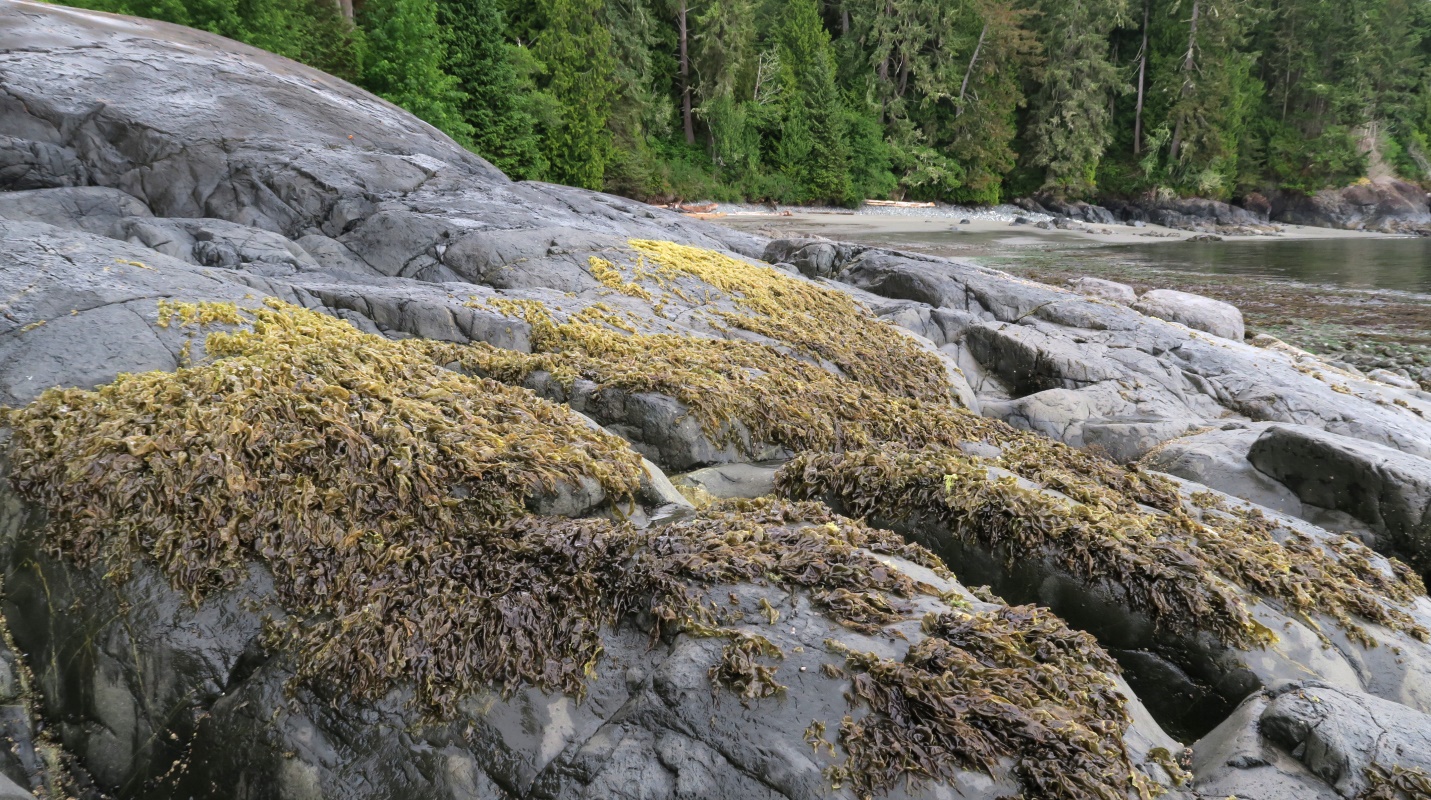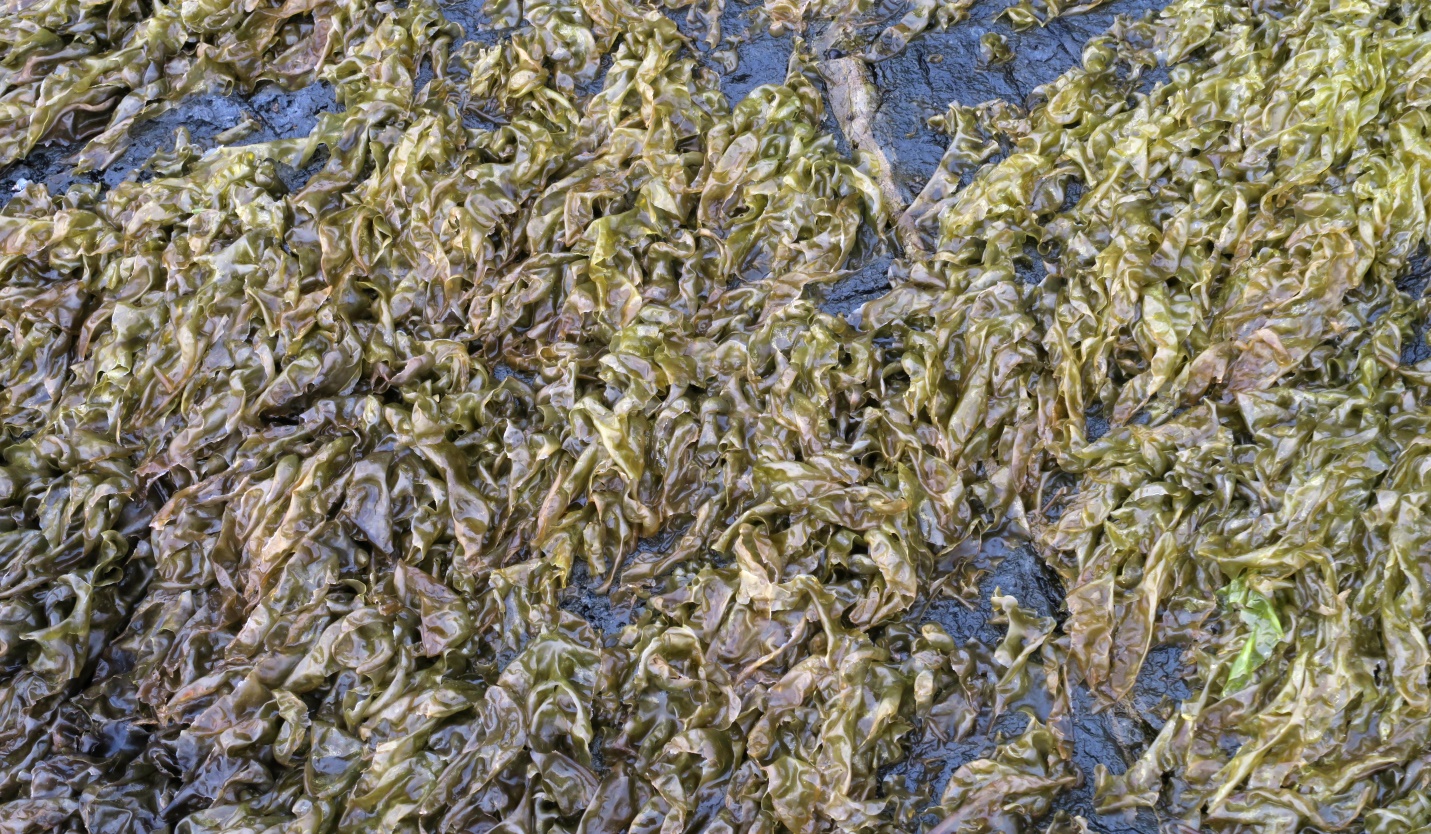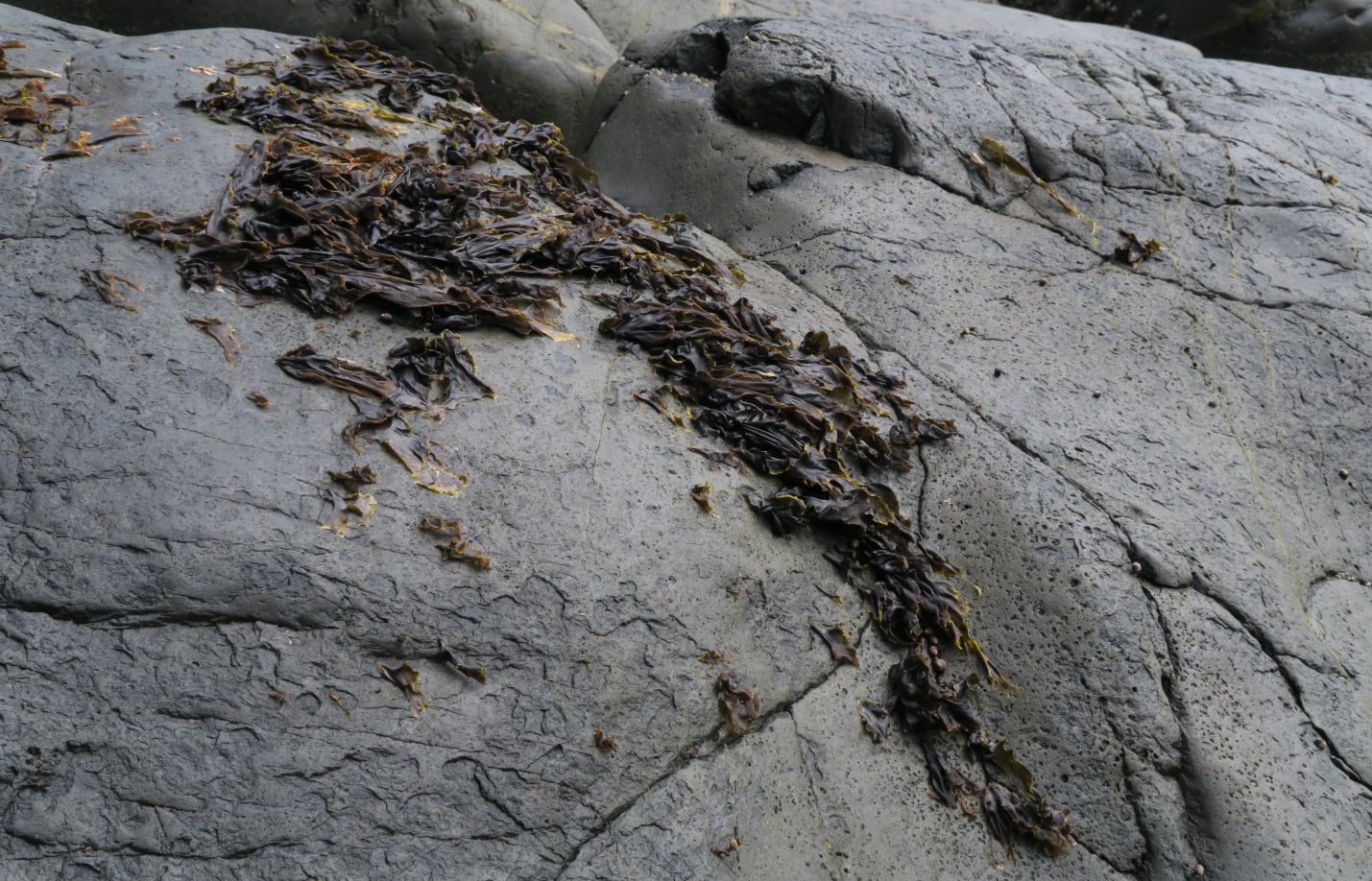
Pyropia pseudolanceolata
Olive Green Winter Laver
Observations conducted: 14 June 2021, (start time 11:40am PDT)
Fishboat Bay, Juan de Fuca Strait, B.C., Canada
Tide: 1.0 foot tide 11:30am PDT (measured at Sheringham Point Tidal Station)
Conditions: Partly cloudy (40% cloud cover), no precipitation, wind SE 5 – 10 km/hr, sea rippled, 18˚C.
Phase of Moon: Waxing Cresecent (approx. 104 hours into this phase at time of interaction); (Previous Phase, New Moon, 10 June 2021 at 3:52am PDT: Next Phase, First Quarter, 17 June 2021 at 8:54pm PDT.)

Figure 1: Olive Green Winter Laver, Pyropia pseudolanceolata, growing high atop the bedrock that rims this shoreline. Fishboat Bay, Strait of Juan de Fuca, B.C. Canada. May 27, 2021. Photo ID 27318 ©Seaweedwhisperings.com
Person 1:
From a distance you look sad and weeping, but up close you seem to be simply flopped over the rocks, basking in the sun.
Higher specimens are on the yellow side of olive, lower down they are dark green to purple.
I put my palm over a patch of Pyropia and patted it – very soft and spongy.
Tried chewing – too tough to bite through. Almost rubbery. Tried a smaller piece, but still could not break it with my teeth – it’s a tough one!
Growing exposed, hanging on, sloping down, on its way down.
Accomplished, stoic.
Not creative.
All align the same way, compliant.
Principled, observant.
Difficult for others to see what’s behind its outward presentation.
Person 2:
I am splayed out on the surf polished bedrock in order to photograph you, Pyropia pseudolanceolata, and as a result I am in your element.
Here you are, stretched out horizontally.
Your ruffled layers today are deep, purple-y black looking – edged with olive green or rust.
Crispy – you look to be dried to a crisp compared to when I saw you two and one half weeks ago (at that time your color was a light olive green).
High up here, highest of high tide seaweeds, you are laid out beneath the sun and drying out…, to your death, perhaps?
Some pieces of you are broken off near your holdfast, and with others, there is almost nothing left of you (just the smallest trace of a holdfast).
Touch you with my palm – stiff and crisp and makes a rustling noise, but you somehow still have some elasticity to you…, ah, yes, it rained last night. I guess you are quite tolerant of fresh water as at this location you might get as much of that (or more) in spring than you do of any ocean spray and splash.
I tugged a piece and had to pull harder than expected to free you.
Chewy! You’re chewy and toughened – like a dried beef jerky but more rubbery.
Salty taste at first and then reduces to no taste really at all, but lots of texture.
And texture is what your being here gives these rocks – an overall “plant” softness and texture and pattern to the smooth bedrock.
I think your personality is textured and layered, too.
There is much to you, but upon first glance you appear somewhat uninteresting. Does it suit you to be left alone, to not have others show much interest in you individually?
Tough – you can withstand much and you can thrive in this area that is really very much to the sidelines of the main action areas of the species-rich intertidal zone.
Soon your season will be done – however I have no doubt you’ll be back next year!
I look forward to meeting with you again.

Figure 2: Closer view of Pyropia pseudolanceolata, Olive Green Winter Laver. Fishboat Bay, Strait of Juan de Fuca, B.C. Canada. May 27, 2021. Photo ID 27319 ©Seaweedwhisperings.com
Discussion:
This seaweed makes a presence, growing as it does high up in the intertidal zone, boldly atop the surfaces of rocks and boulders. Yet, it is so far up above the beach here, that it almost sets itself apart, detached from all the other ‘seaweed action’. It feels almost like they were handed this job – “grow way up here, and do it in whatever season you can manage to succeed” and Pyropia pseudolanceolata went out and accomplished just that. But the feeling is that this is not truly their own agenda, and indeed, once they’re “on the job” they can behave / grow only in alignment with the harsh parameters of gravity, wave action, daylight, temperature and other weather factors. Their options are limited if they are to continue to survive here.
In this it feels like Olive Green Winter Laver will subdue their own inner desires, repress their own personality to some large extent, in order to accomplish their task. Indeed they become quite accomplished at their task and they seem rather stoic – living out in the open and dramatically exposed to the elements. Perhaps this is a ‘duty’ somehow, and one that requires continued principled attention and effort.
There is seasonality to this seaweed that is plainly evident. In winter and very early spring the young and green Pyropia pseudolanceoata has a wispy, almost ethereal quality. Indeed with nearly transparent blades, one could think there’s not much to them, or maybe it’s simply the fact that the layers of folded blades obscure any kind of full view of them. Maybe they are sheltered behind ‘curtains’ of their own devising, because as the season progresses and if you actually press on and seek to learn more, you find that there is a character behind the masking folds and layers that has a true but quiet strength. Perhaps Olive Green Winter Laver would rather divert your attention from them, as there is a feeling that they are not quite wholly aligned with their task / job – they’re certainly doing their best, but the effort has been assigned to them. Somehow the choice was not one entirely of their own making and in that, Pyropia, you have a reserved and somewhat wistful quality. Could it be a touch of regret or longing…? And maybe this is why you cannot endure perennially. Out of season you disappear completely, and would this be a time when you are not ‘on duty’ and thus you do entertain other possibilities?

Figure 3: Spring was extended this year with unseasonably cool weather and much rain; as a result Pyropia pseudolanceolata persisted much longer into the warm season, but it is pictured here as it is beginning to “disappear” for this year. This photograph was taken just 2 ½ weeks later than Figure 2. Fishboat Bay, Strait of Juan de Fuca, B.C., Canada. June 14, 2021. Photo ID 27320 ©Seaweedwhisperings.com
Biology & Natural History Information:
Description:
Thallus is an olive green blade that can grow to 30 cm long but is usually much shorter. When young the blades are lanceolate but they become rounder and fuller near the base as they mature. Like many other members of the genus Pyropia, Olive Green Winter Laver is only one cell layer thick. Male cells are found in whitish margins of the blades; fertilized female cells are in ‘hieroglyphic like streaks’ across distal ends of separate female plants. Indeed the reproductive secrets of this group of seaweeds had been a puzzle for decades, with early phycologists declaring that there was “no sex” in these plants.
Habitat:
This species is restricted to high intertidal bedrock on exposed coast in winter; it survives into spring or even summer in colder sites.
North Pacific Distribution:
Aleutian Islands, Alaska to Del Norte County, California.
Remarks:
The genus Pyropia has recently undergone substantial revision, gaining a number of species that were previously classed in the genus Porphyra. Pyropia is derived from the Greek meaning ‘fire’, but only some species are colored red in this manner. All species, even if their blades reach 1 meter in length, are either only one or two cell layers thick. They look nearly transparent and are colored from whitish yellow to olive-green, from brownish red to rose red and various shades of purple. Interest in the genus originated from their economic value as this is the algal group that produces nori, the quintessential ingredient of sushi making.
Classification:
Phylum: Rhodophyta
Class: Bangiophyceae
Order: Bangiales
Family: Bangiaceae
Genus: Pyropia
Species: Pyropia pseudolanceolata (V.Krishnamurthy) S.C.Lindstrom 2011
Former name(s): Porphyra pseudolanceolata
![]()